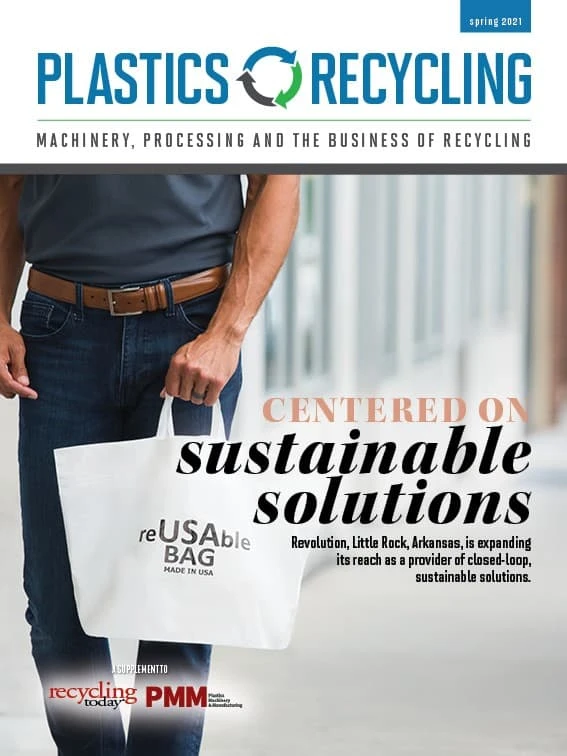
Pyrolysis. A patent awarded to Agilyx Corp., Tigard, Oregon, describes systems and methods for recycling plastic scrap, including polystyrene (PS).
Depending on the feedstock and methods used, the feedstock could be converted into a crude oil that can be stored, transported and refined, or it could be converted into a styrene monomer.
In some embodiments of the invention, the scrap feedstock can consist of mixed plastics that have been ground, chipped or reduced in size in some other way; the feedstock also can be primarily PS scrap. The scrap can be fed into the system in a continuous manner, and the feed apparatus can include conveyors, bins, hoppers and other equipment. The process can include mixing, heating and compacting steps, which can be accomplished with a compactor and a premelter, for instance, to produce a continuous stream of densified plastic melt. From there, the feedstock could flow into a pyrolysis recovery unit (PRU)—or, in other embodiments, the feedstock flows directly into the PRU.
The PRU can have multiple heating zones, and the heat depolymerizes the feedstock and gasifies or vaporizes a portion of it. Depending upon the embodiment, the feedstock can be heated under atmospheric or vacuum conditions or with negative or positive pressure. The PRU’s output is then split into separate streams of hydrocarbon gas and residue solids.
According to the patent, “The organic gases can include, for example, one or more paraffins, olefins, naphthenes, aromatics and/or other classes of hydrocarbon materials. … For example, the vapor can include one or more alcohols, ketones, ethers, phenols, carboxylic acids or other polar organic molecules.”
From the PRU, the vapor moves to a quenching step, with the quenched pyrolysis gas moving on to a condenser or series of condensers, then on to a supplemental condenser. The supplemental condenser can separate light hydrocarbons, while remaining vapors pass through a caustic scrubber and an emissions control device before being vented.
In the case of feedstock consisting primarily of PS scrap, the vapor stream can be condensed to isolate oligomers. The oligomers can be routed back into the PRU, and the styrene can be condensed and then sent through a supplemental condenser to extract light hydrocarbons.
Using mainly PS scrap as feedstock, the process can recover a purified styrene monomer oil product and oligomers.
Patent 10,731,080; issued Aug. 4, 2020
Plastics sorting. A patent awarded to Freiburg im Breisgau, Germany-based Polysecure GmbH describes a marker that can be blended into plastic material to make it fluoresce at certain wavelengths, so recycling plants can sort material that might otherwise damage equipment. The process requires a special light source—preferably a laser—that can luminesce a material stream, as well as optical equipment, such as a camera, that can detect the glowing materials.
The patent notes that recycling mixed plastic scrap, for example, polyvinyl chloride (PVC) plastic windows, profiles and production scrap, is an established process. However, it can be difficult to detect foreign substances, such as glass-fiber reinforcement or additives, that have been mixed with a stream of a homogeneous plastic material. Such substances, which are abrasive, can damage extruders and filter apparatuses.
The proposed method involves blending anti-Stokes crystals or pigments into plastic material at a concentration, based on the total weight of the plastic material, ranging from 10 to 200 parts per million. This avoids trouble downstream when it’s recycled. The materials could include glass-fiber-reinforced PVC. The crystals or pigments fluoresce when a light source emits a particular wavelength that excites them. According to the patent, “… it has been found that the fluorescent materials … exhibit such chemical, thermal and ultraviolet-light stability that they can fulfill their function throughout the entire life cycle of the material, even if the material is processed in several recycling cycles.”
Some current processes require more sophisticated cameras than those needed for the described process, the patent notes.
After materials are reduced to a size range of between 0.1 centimeter (cm) and 2 cm, a specific wavelength of light can be directed at the particles. Only the particles containing that specific marker will fluoresce, and they can be removed.
According to the patent, crystals attuned to different wavelengths can be blended into materials that have different additions or attributes, enabling separation of multiple fractions from the material stream using multiple sorting stages.
Patent 10,717,113; issued July 21, 2020

Explore the Spring 2021 Plastics Recycling Issue
Check out more from this issue and find your next story to read.
Latest from Recycling Today
- AF&PA report shows decrease in packaging paper shipments
- GreenMantra names new CEO
- Agilyx says Styrenyx technology reduces carbon footprint in styrene production
- SABIC’s Trucircle PE used for greenhouse roofing
- Hydro to add wire rod casthouse in Norway
- Hindalco to invest in copper, aluminum business in India
- Recycled steel price crosses $500 per ton threshold
- Smithers report looks at PCR plastic’s near-term prospects





